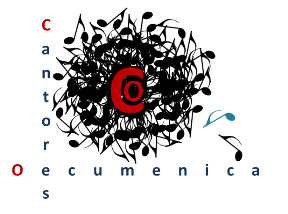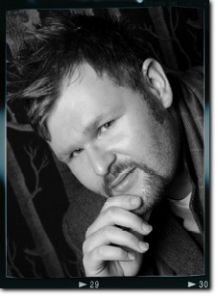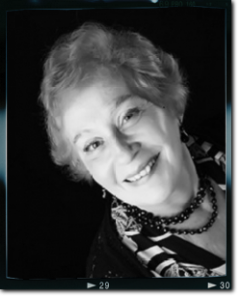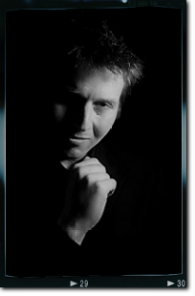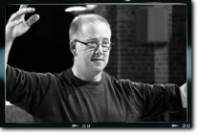St John Passion - Bob Chilcott
Cantores Oecumencia performed Bob Chilcott's oratorio, St John Passion, on Palm Sunday 2017. You can see the soloists and professional musicians below.
Bob Chilcott’s setting of the Passion is an hour-long work telling the story of Christ’s trial and Crucifixion using the text from St John’s Gospel. The St John Passion was a commissioned work for Matthew Owens and the Choir of Wells Cathedral. The first performance was given on Palm Sunday, 23rd March 2013.
“The whole work is about the death of Jesus, and in the end, we realise that it is also about our own death. It is a heartfelt blend of words and music, the one informing the other“ writes Bob Chilcott. In composing the Passion, Chilcott has been very aware of the towering example of J. S. Bach, as well as the contemporary sacred music of Arvo Pärt and James MacMillan. Chilcott’s music grows from the text, which is very carefully chosen. The medieval poetry used here speaks to him in recognition of how much mortal man holds onto earthly pleasures, while at the same time wanting to praise God in Jesus. This is most evident in the Meditation ‘Miserere, my Maker’, which he calls a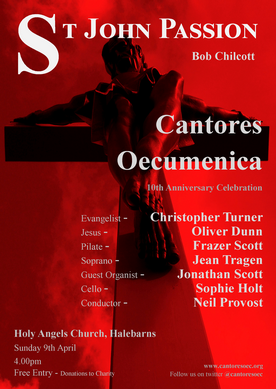 ‘Love Song to God’. In this poem he finds the human in the heavenly; the medieval and Renaissance poetry in particular move the composer deeply: ‘These poets articulate the human dimension of religion’, he says. From all of the above, it is clear that Chilcott is a great communicator who chooses his texts carefully.
‘Love Song to God’. In this poem he finds the human in the heavenly; the medieval and Renaissance poetry in particular move the composer deeply: ‘These poets articulate the human dimension of religion’, he says. From all of the above, it is clear that Chilcott is a great communicator who chooses his texts carefully.
 ‘Love Song to God’. In this poem he finds the human in the heavenly; the medieval and Renaissance poetry in particular move the composer deeply: ‘These poets articulate the human dimension of religion’, he says. From all of the above, it is clear that Chilcott is a great communicator who chooses his texts carefully.
‘Love Song to God’. In this poem he finds the human in the heavenly; the medieval and Renaissance poetry in particular move the composer deeply: ‘These poets articulate the human dimension of religion’, he says. From all of the above, it is clear that Chilcott is a great communicator who chooses his texts carefully.The work is scored for soprano, tenor and two baritone soloists, mixed choir, solo viola and cello, brass quintet, organ, can timpani. Cantores Oecumenica will be performing the work with just the organ and cello. As in the great Passion settings by J.S. Bach, the story is narrated by a tenor Evangelist. Chilcott designed the narrative to be sung in an arioso style that gains momentum as the drama unfolds. The solo roles in the narrative are identified with specific instruments from the ensemble.
The role of the choir within the narrative is to play the part of the crowd or a group of soldiers who comment from time to time in short outbursts. The larger role for the choir is the singing of four meditations that punctuate various points in the drama. Chilcott has tried in these meditations to emulate the style of a strophic carol in the mould of a writer such Thomas Ravenscroft, cast in a simple, melodic way. The texts are taken from English poems from the thirteenth to the early seventeenth centuries that express deeply human responses to death, to life, and to man’s relationship with the world and with God. Two of these meditations are sung by the choir with soprano solo, the last of which (‘Jesus, my Leman’) expresses most poignantly the human response to seeing Christ crucified on the Cross. Chilcott also set five well-known Passiontide hymn texts which are designed to be sung by the choir and audience/congregation together.
The Evangelist (tenor) narrates the action of St John’s Gospel as heard in ‘the vital language of the King James Bible’. Chilcott says that he is fortunate to have sung the part of the Evangelist in Bach’s Passions several times, but he remembers with particular warmth the impact of the simple Renaissance versions of the Passiontide music chanted by the Dean and Chaplain of King’s College Cambridge in Holy Week. ‘The austerity, the agony and ultimately the grace of this story have inspired me to write this piece’, he says. Reviewers have described his work as ‘a mighty setting of words from the Gospel of St John’.
Chilcott’s lyrical writing for the Evangelist throughout this work enables the narrative to gain momentum as the drama builds. The choir portrays the mob in the Garden of Gethsemane; they comment on Peter’s denial and Pilate’s words; then speak at the Crucifixion itself, with the Evangelist and Jesus. The small parts of A Woman, Peter, Officer and Servant are sung by choir members.
The four Meditations allow passages of quiet reflection. In two of these, the soprano soloist is supported by the chorus. All of the Meditations are settings of poems from the 13th to the early 17th century. The five hymns (chorales) are settings of familiar words but with new music. They were written for the audience/congregation to sing with the chorus, and we have printed them on a separate sheet. The hymns have also been published separately, for the use of church choirs not large enough to perform the whole Passion.
Bob Chilcott was in his words “fortunate as a singer to perform the Evangelist role in both the great Passions of Bach a number of times”. It is the austerity, the agony, and ultimately the grace of this story that inspired him to write this piece.
The Soloists and Professional Musicians
Christopher Tuner - Tenor
(click on Christopher's image to see his biography)
Adam Marsden - Baritone
(click on Adam's image to see his biography)
Frazer B. Scott
(click on Frazer's image to see his biography)
Jean Tragen - Soprano
(click on Jean's image to see her biography)
Jonathan Scott - Guest Organist
(click on Jonathan's image to see his biography)
Neil Provost - Conductor
(click on Neil's image to see his biography)
Sophie Holt - Cellist
(click on Sophie's image to see her biography)

